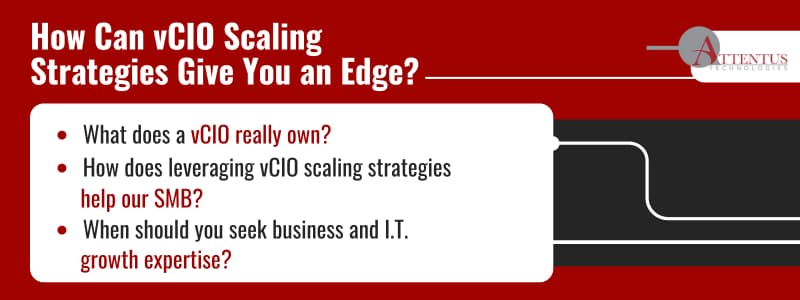Growth should be exciting, but for most SMBs, it quickly exposes cracks in their I.T. foundation. Systems buckle, budgets explode, and compliance risks rise. That’s where a vCIO makes the difference.

Could you double headcount or launch a new service line without breaking your systems?
If you hesitated, or couldn’t confidently say “YES,” you’re not alone
Here’s the uncomfortable truth: Scaling is hard. Without a proactive plan, business and I.T. growth strains processes, security, and budgets.
Luckily, it doesn’t have to. A vCIO can provide technology leadership to ensure growth is built on a solid foundation.
Here’s what to know about vCIO scaling strategies.
What a vCIO Really Owns (and Why It’s Different from ‘Support’)
So what is a vCIO, and what do they actually do?
You’re likely familiar with the term chief information officer (CIO). This is typically someone responsible for overseeing a large organization’s I.T. infrastructure. They look at things like budgeting, analysis, security, and technology, then develop a strategic roadmap to present to the chief executive officer (CEO). The CEO can then make an educated decision about their organization’s I.T. infrastructure.
Most small businesses can’t justify having a full-time CIO on staff, so the CIO role ends up falling into the hands of the CEO. But the CEO is already busy running the day-to-day business and doesn’t have the bandwidth to research new technology and make optimum I.T. decisions.
That’s where a vCIO steps in to bridge the gap.
A vCIO takes all the benefits of a large organization’s CIO and brings them down to smaller organizations at a fraction of the cost. They translate business strategies into executable I.T. roadmaps tied to revenue, margins, and risk.
Their key roles include:
- Strategic planning
- Architecture choices
- Risk and compliance oversight
- Vendor and contract governance
- KPI accountability
Put differently, a vCIO will look at what’s available for technology and how to optimize I.T. growth. This includes examining what other organizations in the same industry are doing and presenting those to the CEO to decide on the best option for your organization.
The vCIO will also analyze industry trends and project what’s going to happen in the I.T. space and what will best benefit your business.
They’ll help you answer “How can my business make the best use of the new technology coming down the road?” and set wheels in motion to actualize those objectives.
On the I.T. budgeting front, your vCIO will also review current expenses and determine how to optimize future spending. They’ll look at which parts of your network and overall environment are the most vulnerable to an attack or likely to fail, then present you with options to bolster those parts and shut down threats so everything runs smoothly.
Let’s explore these seven vCIO scaling strategies in more detail.
1. The Scaling Roadmap: From Current State to Future State
vCIOs create a tailored scaling roadmap with clear steps to move from your current state to your future goals.
During this initial stage, proactive vCIOs:
- Assess your systems, dependencies, costs, and risks.
- Design a target hybrid or cloud architecture, along with data flows and security baselines.
- Create a 12-month roadmap with owners, budgets, and success metrics.
2. Capacity & Performance Planning (Before the Bottlenecks Hit)
A vCIO helps you accurately forecast compute, storage, and network demand and design smart plans to meet them. They right-size license utilization, determine which apps to retire, and streamline user onboarding and offboarding with automation.
For instance, we recently helped a client reduce costs by 20% by identifying and retiring their redundant SaaS licenses after conducting a vCIO audit.
3. Governance & Technology Leadership for Scale
Your vCIO will help you set up a change advisory board (CAB) for approving production changes to minimize unwanted outcomes.
They’ll also design robust governance policies on user access, data classification, and SaaS usage to minimize I.T. sprawl and security risks, as well as schedule quarterly business reviews (QBRs) to keep I.T. efforts aligned with long-term business goals.
4. Budgeting for I.T. Growth: From Surprise Costs to Planned Investments
Don’t want I.T. to turn into a cost center down the road? You’re in luck, because a vCIO models the total cost of ownership (TCO) of technology (including training, support, integration, and security) so you know what to expect from the start.
They will also go a step further and help you plan refresh cycles and cloud subscriptions to keep CapEx and OpEx balanced and predictable.
5. Security & Compliance at Scale (Don’t Grow Your Attack Surface)
Want robust, adaptable security and compliance? A vCIO brings you closer to that reality by:
- Establishing identity-first security with MFA and role-based access control.
- Creating immutable, encrypted backups and a data loss prevention policy.
- Tying security controls to applicable regulatory frameworks so you pass every audit with flying colors.
6. Cloud & Vendor Strategy that Enables (Not Hinders) I.T. Growth
Your vCIO helps you determine the correct cloud approach for workload placement, such as whether to use software, platform, or infrastructure as a service.
They will look at which tools overlap, eliminate that redundancy, and negotiate every element of your vendor contracts, from integration commitments to exit clauses, on your behalf.
7. Business Continuity & Change Management
Finally, a vCIO will define, document, and implement a tailored business continuity strategy.
They’ll make the transition easy for users with role-based training and effective communication about new tools, and measure utilization of those tools to determine what to iterate on or retire.
When to Bring in a vCIO & Engagement Models
Not sure if vCIO services are right for you? Pause for a moment and consider these questions:
- Are you in a period of growth and need to hire rapidly?
- Is there an M&A underway or on the horizon?
- Have you recently faced a security or compliance scare?
- Do I.T. projects keep stalling?
- Does your technology budget sometimes feel unpredictable?
If you answered “yes” to any of these, you’ll likely benefit from vCIO scaling strategies. In that case, three models are available to you: fractional vCIO services, project-based strategy sprints, or an ongoing retainer.
If you’re doubling headcount, merging with another company, or just frustrated with ballooning IT costs, a vCIO can provide the clarity you’ll need before growth strains your systems even further.
Tactical I.T. Won’t Scale a Growing Business
Why is scaling often a nightmare for SMBs?
- Tool sprawl and shadow I.T.
- Projects without owners, KPIs, or training
- Over-customization limits possible upgrades
A vCIO helps you avoid all these with a proper strategy from day one.
Ultimately, reactive support only fixes symptoms. If you want to prevent repeat failures and align tech with growth, lean into vCIO scaling strategies.
Attentus Technologies’ vCIO scaling strategies provide technology leadership that turns business and I.T. growth plans into sustainable outcomes.
One of our core values is “Be the Answer,” and as such, we’ll deliver a 90-day vCIO roadmap with KPIs, budget forecast, and risk priorities, so I.T. scales as fast as your business.
Schedule a free consultation to learn more about the benefits of working with a proactive I.T. partner.
